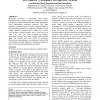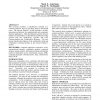CSCW
1996
ACM
14 years 3 months ago
1996
ACM
Our experience with Internet-based scientific collaboratories indicates that they need to be user-extensible, allow users to add tools and objects dynamically to shared workspaces...
CSCW
1996
ACM
14 years 3 months ago
1996
ACM
Workspace awareness is knowledge about others' interaction with a shared workspace. Groupware systems provide only limited information about other participants, often comprom...
CSCW
1996
ACM
14 years 3 months ago
1996
ACM
Collaborative systems provide a rich but potentially chaotic environment for their users. This paper presents a system that allows users to control collaboration by enacting polic...
CSCW
1996
ACM
14 years 3 months ago
1996
ACM
We begin by reviewing current spatial approaches to CSCW (mediaspaces, spatial video conferencing, collaborative virtual environments and telepresence applications) and classifyin...
CSCW
1996
ACM
14 years 3 months ago
1996
ACM
In order to understand some problems associated with workflow, we set out an analysis of workflow systems, identifying a number of basic issues in the underlying technology. This ...
CSCW
1996
ACM
14 years 3 months ago
1996
ACM
CSCW toolkits are designed to ease development of CSCW applications. They provide common, reusable components for cooperative system design, allowing application programmers to co...
CSCW
1996
ACM
14 years 3 months ago
1996
ACM
This research examines a collaborative solution to a common problem, that of providing help to distributed users. The Answer Garden 2 system provides a secondgeneration architectu...
CSCW
1998
ACM
14 years 3 months ago
1998
ACM
Media space applications that promote informal awareness in an organization confront an inevitable paradox: the shared video connections between offices and rooms that promote inf...
CSCW
1998
ACM
14 years 3 months ago
1998
ACM
Usenet may be regarded as the world’s largest conversational application, with over 17,000 newsgroups and 3 million users. Despite its ubiquity and popularity, however, we know ...
CSCW
1998
ACM
14 years 3 months ago
1998
ACM
The growth in interest in virtual environments in CSCW has focused on co-operation within these environments. Little consideration has been given to how users manage these environ...


